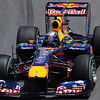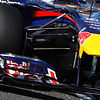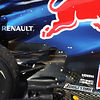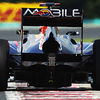Red Bull RB6 Renault
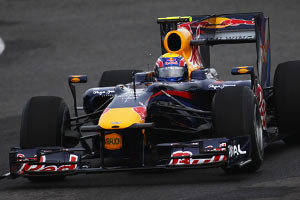
Active: 10-02-2010 - 2010
Team: Red Bull Racing
Team: Christian Horner (TP), Adrian Newey (CTO), Peter Prodromou (HA), Rob Marshall (CD)
Drivers: Sebastian Vettel (5), Mark Webber (6)
The Red Bull RB6 is the successor of the RB5 that was the quickest car in the second half of 2009. With the same technical team, the RB6 is a clear evolution with the car looking very similar, despite containing a much larger fuel tank.
The team chose to not participate in the first winter test of 2010 to have more time for its development. As a result, the RB6 made its track debut on 10 February at Jerez.
The team's technical director, Adrian Newey explained: "There’s more to it than simply putting a big fuel tank in the car. The bigger fuel tank puts more load on the brakes, so the brake cooling has to cope with that. You also have to consider what effect that extra fuel will have on the tyre degradation early in the race and if there’s anything we should change mechanically to cope with that. The narrower front tyre changes weight distribution and the balance of the car."
Additionally, the RB5 was initially not designed to fit a double deck diffuser, while the winter development for the RB6 allowed to put much focus on that aspect of the car. "One obvious difference is that the 2009 car was not designed to suit a double-diffuser and we had to try to put one on as best we could around the existing rear suspension and gear box. With this car we’ve been able to design the car from scratch."
Just like the RB5, the 2010 contender is fitted with a Renault RS27 engine, despite attempting to seal a deal with Mercedes. The Renault is however upgraded as the French constructor was allowed to make some changes in order to close the performance gap with the fastest engines.
Technical analysis
The new car is not the revolution that many hoped for and hence looks very similar to its predecessor.
At the front, a new wing is likely to be introduced before the start of the season. The current version is similar to that of the RB5. The stacked elements are slightly changed as the tips are now rounded to reduce wingtip vortices. The front wing endplates are the most simple we have yet seen on any of the launched cars. It really are simple panels that are sharply curved ahead of the front tyres.
The nose cone has been made a little bit wider but still features the rounded bottom, while at the top two ears are still present, albeit made slightly shorter. These hubs are still used to host the rockers for the front suspension's push rods. The team did however choose to relocate the steering arms, now a little bit lower than before.
Interesting about the nose are the small strips added to each side of the nose ahead of the front suspension arms. Adrian Newey clearly got his mustard here from the Brawn BGP001.
The frontal area of the sidepods has also largely been left unchanged, with the cooling entries looking similar to last year's. The barge boards now have a jagged edge, while the mirrors are positioned on the sidepod panels, just like most other teams have also done.
Despite putting in a much larger fuel tank, the sidepods are still heavily undercut. It can be considered a real achievement that visually most components behind the driver's head have been carried over from the successful Red Bull RB5.
The rear diffuser is also a point of interest where much time can be gained this year. Red Bull already had a high crash structure and the concept has been deepened. The rear light is now higher than before and fixed on the crash structure that runs up at 45°. Around it is the new diffuser, featuring curves similar to a diffuser version McLaren ran in 2009.
Specifications
Chassis: Composite monocoque structure, designed and built in-house, carrying the Renault V8 engine as fully stressed member
Front suspension: Aluminium alloy uprights, carbon-composite double wishbone with springs and anti-roll bar, Multimatic dampers
Rear suspension: Aluminium alloy uprights, carbon-composite double wishbone with springs and anti-roll bar, Multimatic dampers
Brakes: Brembo calipers, Brembo carbon discs and pads
Electronics: FIA (MESL) standard control unit
Fuel: Total Group
Wheels: OZ Racing (front: 12.7in x 13in; rear: 13.4in x 13in)
Tires: Bridgestone
Brakes: Brembo
Transmission
Gearbox: Seven-speed gearbox, longitudinally mounted with hydraulic system for power shift and clutch operation.
Clutch: AP Racing
Engine
Type: Renault RS27 - 2010
Configuration: 90° V8
Capacity: 2400cc
Max RPM: 18,000 rpm (limit mandated by FIA)
Number of Valves: 32
Engine construction: Cylinder block in cast aluminium
Engine management: FIA (MESL) standard control unit TAG310B
Oil: Total Group
Weight: FIA minimum weight of 95kg

